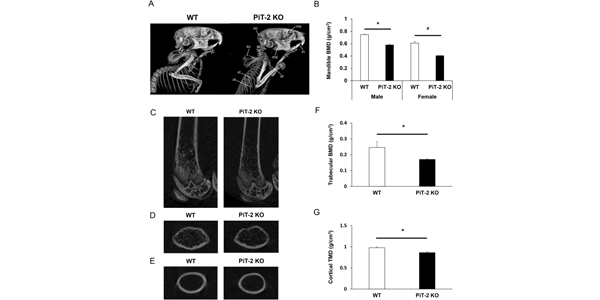Image: Global PiT-2 homozygous knockout mice exhibit reduced bone and tissue mineral density
Shunsuke Yamada, Mary C.Wallingford, Suhaib Borgeia, Timothy C.Cox, Cecilia M.Giachelli
Biochemical and Biophysical Research Communications, Available online 11 November 2017.
Abstract
Normal bone mineralization requires phosphate oversaturation in bone matrix vesicles, as well as normal regulation of phosphate metabolism via the interplay among bone, intestine, and kidney. In turn, derangement of phosphate metabolism greatly affects bone function and structure. The type III sodium-dependent phosphate transporters, PiT-1 and PiT-2, are believed to be important in tissue phosphate metabolism and physiological bone formation, but their requirement and molecular roles in bone remain poorly investigated. In order to decipher the role of PiT-2 in bone, we examined normal bone development, growth, and mineralization in global PiT-2 homozygous knockout mice. PiT-2 deficiency resulted in reduced vertebral column, femur, and tibia length as well as mandibular dimensions. Micro-computed tomography analysis revealed that bone mineral density in the mandible, femur, and tibia were decreased, indicating that maintenance of bone function and structure is impaired in both craniofacial and long bones of PiT-2 deficient mice. Both cortical and trabecular thickness and mineral density were reduced in PiT-2 homozygous knockout mice compared with wild-type mice. These results suggest that PiT-2 is involved in normal bone development and growth and plays roles in cortical and trabecular bone metabolism feasibly by regulating local phosphate transport and mineralization processes in the bone. Further studies that evaluate bone cell-specific loss of PiT-2 are now warranted and may yield insight into complex mechanisms of bone development and growth, leading to identification of new therapeutic options for patients with bone diseases.



